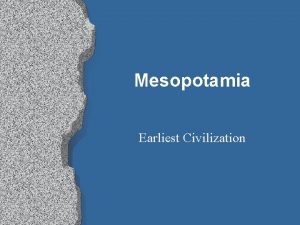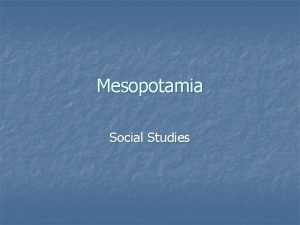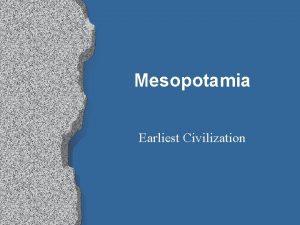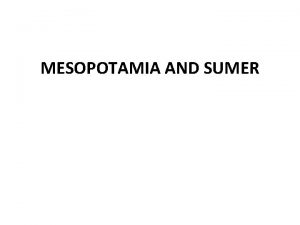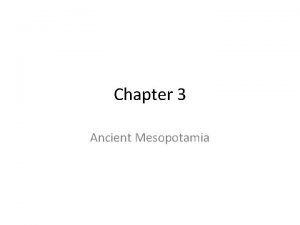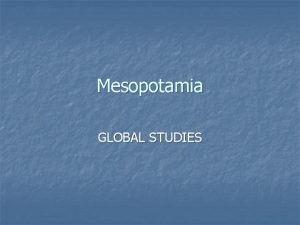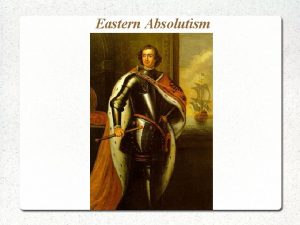Mesopotamia Mesopotamia Mesopotamia is at the eastern end





















- Slides: 21

Mesopotamia

Mesopotamia • Mesopotamia is at the eastern end of the Fertile Crescent, an arc of land from the Mediterranean Sea to the Persian Gulf.

Mesopotamia • Mesopotamia (“between the rivers”) is the valley between the Tigris and Euphrates Rivers. • These rivers often overflow and leave silt, which makes the soil rich for a flourishing agricultural economy. • Mesopotamian civilization was one of history’s important early civilizations to grow in a river valley.

Mesopotamia • Developing consistent agriculture required controlling the water supply. • People in Mesopotamia, therefore, developed a system of drainage ditches and irrigation works. • The resulting large food supply made possible significant population growth and the emergence of civilization in Mesopotamia.

Sumer • Mesopotamian civilization involved many peoples. • The Sumerians developed the first Mesopotamian civilization.

City States • By 3000 B. C. the Sumerians had formed a number of city-states centered around cities such as Ur and Uruk. • These states controlled the surrounding countryside politically and economically. • City-states were the basic political unit of the Sumerian civilization.

Sumerian Architecture • The Sumerians built largely with mud bricks. • Using them they invented the arch and the dome and built some of the largest brick buildings in the world.

Sumerians • The most important building in each city was the temple. • Often it was built on top of a massive stepped tower called a ziggurat. • Sumerians believed gods and goddesses owned and ruled the cities.

Ziggaurat

Sumerian • The Sumerian economy was principally agricultural, but manufacturing, for example, metalwork, and trade, for example wheat, were important.

Invention of the wheel • The invention of the wheel around 3000 B. C. facilitated trade. • Sumerian War Chariot

Classes • The Sumerian city-states had three classes: nobles, commoners, and slaves. • Nobles included the royal family, royal officials, priests, and their families. • Commoners worked for large estates as farmers, merchants, fishers, and craftspeople. • Around 90 percent of the people were farmers. • Slaves principally worked on large building projects, wove cloth, and worked the farms of the nobles.

Code of Hammurabi

Code of Hammurabi • The Code of Hammurabi is one of the world’s most important early systems of law. • It calls for harsh punishments against criminals. • The principle of retaliation (“an eye for an eye, a tooth for a tooth”) is fundamental in Hammurabi’s code.

Code of Hammurabi • Punishments varied according to social status. • A crime committed against a noble brought a harsher punishment than the same crime committed against a commoner. • Hammurabi’s code punished public officials who failed in their duties or were corrupt. • It also had what we would call consumer protection provisions, for example, holding builders responsible for the quality of their work.

Religion • Due to the harsh physical environment and famines, Mesopotamians believed that the world was controlled by often destructive supernatural forces and deities. • The Mesopotamians were polytheistic because they believed in many gods and goddesses. • They identified three thousand of them. • Human beings were to serve and obey the gods and goddesses.

Creativity • They created a system of writing called cuneiform (“wedge-shaped”). • They used a reed stylus to make wedge-shaped markings on clay tablets, which were then baked in the sun.

Cuneiform

Scribes • Writing was used for record keeping, teaching, and law. • A new class of scribes (writers and copyists) arose. • Being a scribe was the key to a successful career for an upper-class Mesopotamian boy. • Writing also passed on cultural knowledge from generation to generation, sometimes in new ways.

Epic of Gilgamesh • The Epic of Gilgamesh, the most important piece of Mesopotamian literature, teaches the lesson that only the gods are immortal. • Gilgamesh is wise and strong, a being who is part human and part god. • Gilgamesh befriends a hairy beast named Enkidu. • When Enkidu dies, Gilgamesh feels the pain of his friend’s death, and he searches for the secret of immortality. He fails.

Creativity • The Sumerians invented important technologies, such as the wagon wheel. • In mathematics they invented a number system based on 60, and they made advances in applying geometry to engineering. • In astronomy, the Sumerians charted the constellations using their number system of 60.
 What decreases stroke volume
What decreases stroke volume Comet nlp
Comet nlp Linksappendizitis
Linksappendizitis Protect
Protect Stroke volume
Stroke volume Multiple procurement cycles
Multiple procurement cycles End-to-end wireframe parsing
End-to-end wireframe parsing End to end delay
End to end delay Compiler front end and back end
Compiler front end and back end End to end argument in system design
End to end argument in system design End to end
End to end Back end
Back end End to end accounting life cycle tasks
End to end accounting life cycle tasks Chúa sống lại
Chúa sống lại Hươu thường đẻ mỗi lứa mấy con
Hươu thường đẻ mỗi lứa mấy con đại từ thay thế
đại từ thay thế Vẽ hình chiếu vuông góc của vật thể sau
Vẽ hình chiếu vuông góc của vật thể sau Công của trọng lực
Công của trọng lực Tỉ lệ cơ thể trẻ em
Tỉ lệ cơ thể trẻ em Thế nào là mạng điện lắp đặt kiểu nổi
Thế nào là mạng điện lắp đặt kiểu nổi Lời thề hippocrates
Lời thề hippocrates Dạng đột biến một nhiễm là
Dạng đột biến một nhiễm là
























